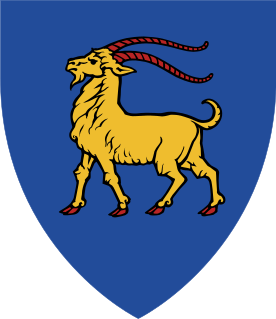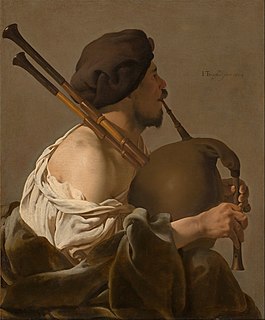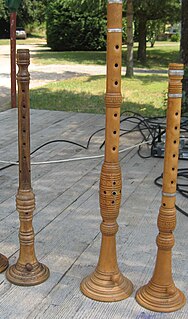
The Istarski mih or Istrian mih is a bagpipe native to the regions of Istria and Kvarner, Croatia. [1]

Istria, formerly Histria (Latin), Ίστρια, is the largest peninsula in the Adriatic Sea. The peninsula is located at the head of the Adriatic between the Gulf of Trieste and the Kvarner Gulf. It is shared by three countries: Croatia, Slovenia, and Italy. Croatia encapsulates most of the Istrian peninsula with its Istria County.

Croatia, officially the Republic of Croatia, is a country at the crossroads of Central and Southeast Europe, on the Adriatic Sea. It borders Slovenia to the northwest, Hungary to the northeast, Serbia to the east, Bosnia and Herzegovina, and Montenegro to the southeast, sharing a maritime border with Italy. Its capital, Zagreb, forms one of the country's primary subdivisions, along with twenty counties. Croatia has an area of 56,594 square kilometres and a population of 4.28 million, most of whom are Roman Catholics.
It consists of a bag made most often from goat skin and a double-chanter with two single reeds. This type of bagpipe is distinct in that it has no drones, but a double-chanter with finger-holes on both bores, allowing both a melody and changing harmony to be played. [2] In this respect the mih more resembles the bagpipes of the Southwest Asia and North Africa than other European bagpipes. The instrument is not dodecaphonically tempered, it is a solistic instrument and it corresponds to the so-called Istrian scale. Due to its specific tone-hole placement, its sound is distinct and unusual even when compared to other instruments of the same "mih" family.

The domestic goat or simply goat is a subspecies of C. aegagrus domesticated from the wild goat of Southwest Asia and Eastern Europe. The goat is a member of the animal family Bovidae and the goat—antelope subfamily Caprinae, meaning it is closely related to the sheep. There are over 300 distinct breeds of goat. Goats are one of the oldest domesticated species of animal, and have been used for milk, meat, fur, and skins across much of the world. Milk from goats is often turned into goat cheese.
"Istrian scale" refers both to a "unique" musical scale and to the Istrian and Kvarnerian folk music genres which use the scale. It is named for the Istrian peninsula. Genres include kanat and tarankanje; techniques include nasal tone, variation and improvisation, and resolution to the unison or octave; and instruments include sopele shawms, bagpipes, flutes, and tambura lutes. It was first named by Ivan Matetić Ronjgov early in the twentieth century, assisting his study and notation of Croatian music.
Unlike other Croatian bagpipe-like instruments that were forgotten and replaced with the accordion and violin in the 20th century, the art of playing istarski mih has not faced such rapid cultural decay. Ivan Matetić Ronjgov, a native Istrian composer, is credited with having revived the art of playing the istarski mih and the shawm-like instrument sopile in the 20th century. Nowadays, these instruments can be frequently seen and heard on many traditional music manifestations across Istria, with many young and perspective players performing and learning to play. Till the end of the second world war, the instrument was present also in the northern part of Ćićarija region, in Slovenia, but the tradition there hasn't been revived since. There are also some players and makers outside Istria, like Stjepan Večković, that contribute to the continuation of the instrument's tradition into the 21st century. [3]

Accordions are a family of box-shaped musical instruments of the bellows-driven free-reed aerophone type, colloquially referred to as a squeezebox. A person who plays the accordion is called an accordionist. The concertina and bandoneón are related; the harmonium and American reed organ are in the same family.

The violin, sometimes known as a fiddle, is a wooden string instrument in the violin family. Most violins have a hollow wooden body. It is the smallest and highest-pitched instrument in the family in regular use. Smaller violin-type instruments exist, including the violino piccolo and the kit violin, but these are virtually unused. The violin typically has four strings tuned in perfect fifths, and is most commonly played by drawing a bow across its strings, though it can also be played by plucking the strings with the fingers (pizzicato) and by striking the strings with the wooden side of the bow.

Ivan Matetić Ronjgov was an Istrian composer.












